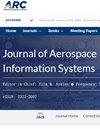用遗传算法选择最小运动原语库
IF 1.5
4区 工程技术
Q2 ENGINEERING, AEROSPACE
引用次数: 0
摘要
运动原语允许应用离散搜索算法在复杂连续空间中快速生成轨迹。机动自动机(MA)为创建基于修剪和机动的原始库提供了一个优雅的公式。然而,性能从根本上受到原语库内容的限制。如果库太稀疏,就路径成本而言,性能可能会很差,而库太大则会增加运行时间。这项工作概述了使用遗传算法修剪原始库的新方法。所提出的方法在保持遗传算法可达性的同时,平衡了路径成本和规划时间。本文采用遗传算法对运动原语库的种群进行评估和变异,以优化这两个目标。我们通过一个非线性中等保真度的F-16模型的仿真研究来说明这些方法的性能。我们用所提出的算法优化了一个库,用于无障碍导航和地球的nap-of- earth导航任务。在无障碍导航任务中,我们以10.16%的计划成本换取96.63%的运行时间改进。在nap-of- earth任务中,我们以9.712%的计划成本换取92.06%的运行时改进。本文章由计算机程序翻译,如有差异,请以英文原文为准。
Selecting Minimal Motion Primitive Libraries with Genetic Algorithms
Motion primitives allow for application of discrete search algorithms to rapidly produce trajectories in complex continuous space. The maneuver automaton (MA) provides an elegant formulation for creating a primitive library based on trims and maneuvers. However, performance is fundamentally limited by the contents of the primitive library. If the library is too sparse, performance can be poor in terms of path cost, whereas a library that is too large can increase run time. This work outlines new methods for using genetic algorithms to prune a primitive library. The proposed methods balance the path cost and planning time while maintaining the reachability of the MA. The genetic algorithm in this paper evaluates and mutates populations of motion primitive libraries to optimize both objectives. We illustrate the performance of these methods with a simulated study using a nonlinear medium-fidelity F-16 model. We optimize a library with the presented algorithm for obstacle-free navigation and a nap-of-the-Earth navigation task. In the obstacle-free navigation task, we show a tradeoff of a 10.16% higher planning cost for a 96.63% improvement in run time. In the nap-of-the-Earth task, we show a tradeoff of a 9.712% higher planning cost for a 92.06% improvement in run time.
求助全文
通过发布文献求助,成功后即可免费获取论文全文。
去求助
来源期刊

Journal of Aerospace Information Systems
ENGINEERING, AEROSPACE-
CiteScore
3.70
自引率
13.30%
发文量
58
审稿时长
>12 weeks
期刊介绍:
This Journal is devoted to the dissemination of original archival research papers describing new theoretical developments, novel applications, and case studies regarding advances in aerospace computing, information, and networks and communication systems that address aerospace-specific issues. Issues related to signal processing, electromagnetics, antenna theory, and the basic networking hardware transmission technologies of a network are not within the scope of this journal. Topics include aerospace systems and software engineering; verification and validation of embedded systems; the field known as ‘big data,’ data analytics, machine learning, and knowledge management for aerospace systems; human-automation interaction and systems health management for aerospace systems. Applications of autonomous systems, systems engineering principles, and safety and mission assurance are of particular interest. The Journal also features Technical Notes that discuss particular technical innovations or applications in the topics described above. Papers are also sought that rigorously review the results of recent research developments. In addition to original research papers and reviews, the journal publishes articles that review books, conferences, social media, and new educational modes applicable to the scope of the Journal.
 求助内容:
求助内容: 应助结果提醒方式:
应助结果提醒方式:


